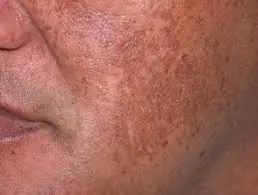
Melasma skin condition is a very common discoloration of the exposed areas of the face among women. Although it can affect anyone, younger women with darker skin tones are at the greatest risk. Another, less common name for melasma, is chloasma. Although melasma is completely harmless, it makes some people feel very self-conscious.
Why Does Melasma Occur?
Melasma is often associated with the female hormones, estrogen and progesterone. It is especially common in pregnant women, women who are taking oral contraceptives, and women using hormone replacement therapy.
Loosely translated, melasma means “black spot.” If you have melasma you’re probably experiencing light brown, dark brown and/or blue-gray patches on your skin. They can appear as flat patches or freckle-like spots. Commonly affected areas include your face, including the cheeks, upper lip and forehead, as well as the forearms. Melasma is sometimes called the “mask of pregnancy” because it frequently affects pregnant women. Melasma typically darkens and lightens over time, often getting worse in the summer and better in the winter.
Melasma appears most commonly on your cheeks, nose, chin, above the upper lip and the forehead. It sometimes affects your arms, neck and back. In fact, melasma can affect any part of your skin that is exposed to sunlight. That’s why most people with melasma notice that their symptoms worsen during the summer months.
How does Melasma occur?
Your skin is made up of three layers. The outer layer is the epidermis, the middle is the dermis, and the deepest layer is the subcutis. Your epidermis contains cells called melanocytes that store and produce a dark color (pigment) known as melanin. In response to light, heat, or ultraviolet radiation or by hormonal stimulation, the melanocytes produce more melanin, and that’s why your skin darkens.
What are the types of melasma?
There are three types of melasma and they have to do with the depth of the pigment. A Wood’s lamp that emits black light may be used to determine the depth of the pigment. The three types are:
Epidermal: Epidermal melasma has a dark brown color, a well-defined border, appears obvious under black light and sometimes responds well to treatment.
Dermal: Dermal melasma has a light brown or bluish color, a blurry border, appears no differently under black light and doesn’t respond well to treatment.
Mixed melasma: Mixed melasma, which is the most common of the three, has both bluish and brown patches, shows a mixed pattern under black light and shows some response to treatment.
Is Melasma a sign of cancer?
Melasma is not cancerous, it is not a sign of cancer, nor is it a skin condition that “turns into” cancer. However, there are skin cancers that may mimic melasma, so it’s important to see your dermatologist on a regular basis.
Melasma Treatment Options
NAWI Naples can treat Melasma with either Laser Genesis or the IPL Photofacial Laser. Click below to learn more about these treatments. Better yet, schedule your no-obligation consultation to better understand your treatment options at NAWI Naples.
Schedule a Consultation
Click here to schedule your no-obligation consultation to learn more about your condition and the available treatments at NAWI Wellness Center
